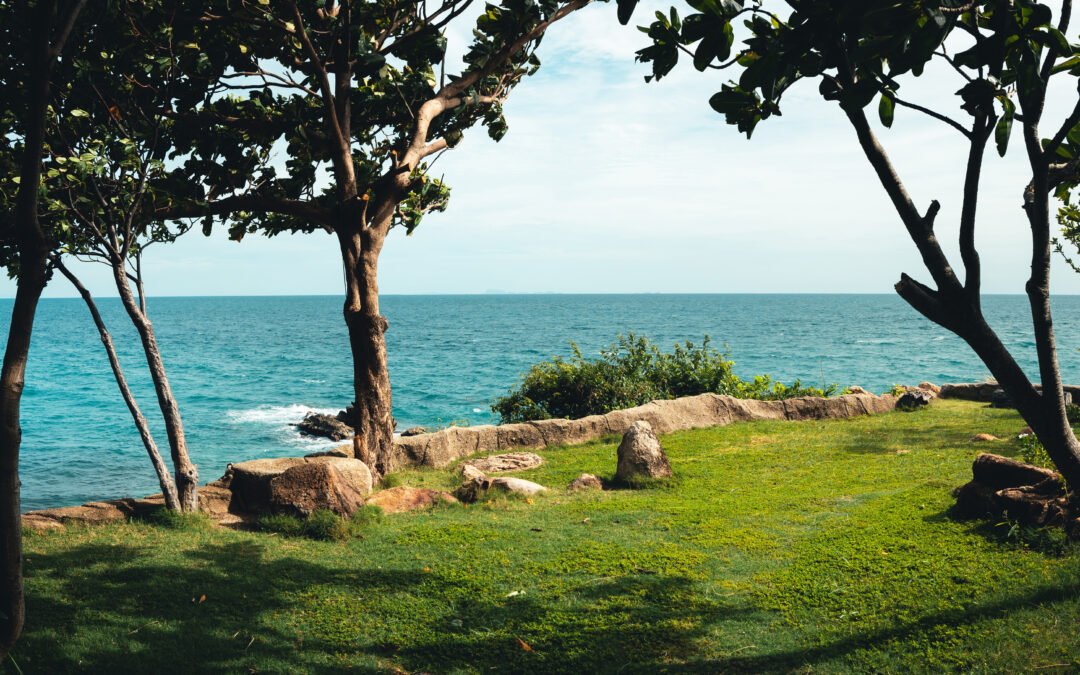Living near the coast offers stunning views and a refreshing atmosphere, but it also comes with unique landscaping challenges. Coastal backyard landscaping requires thoughtful planning to withstand salt exposure, strong winds, and sandy soils while maintaining a lush, inviting outdoor space.
Key Elements of Coastal Backyard Landscaping
Designing a functional and beautiful coastal backyard involves considering several essential factors, including:
- Salt-Tolerant Plants: Choosing hardy plants that thrive in salty air and sandy soils.
- Wind-Resistant Landscaping: Installing windbreaks and selecting durable materials.
- Efficient Drainage Solutions: Preventing water buildup with permeable surfaces.
- Sustainable Design: Using native plants to create a low-maintenance, eco-friendly yard.
- Outdoor Living Spaces: Incorporating patios, decks, and seating areas to enjoy the coastal breeze.
- Erosion Control Strategies: Implementing natural barriers and reinforcements to protect soil from erosion.
- Drought-Resistant Landscaping: Choosing plants that require minimal water to thrive in dry coastal conditions.
Best Plants for Coastal Backyards
Selecting the right plants is crucial for a thriving coastal landscape. Consider the following salt-tolerant and wind-resistant options:
| Plant Type | Recommended Varieties | Benefits |
|---|---|---|
| Trees | Palm trees, Southern Magnolia | Wind resistance, shade |
| Shrubs | Oleander, Wax Myrtle | Privacy, erosion control |
| Flowers | Beach Sunflower, Lantana | Colorful, drought-tolerant |
| Ground Covers | Sea Oats, Creeping Thyme | Soil stabilization, aesthetics |
| Grasses | Zoysia Grass, Seashore Paspalum | Low maintenance, soft underfoot |
Hardscaping for Coastal Backyards
Adding durable hardscape elements enhances the beauty and functionality of your coastal yard. Consider these options:
- Permeable Pavers: Allow water to drain effectively and prevent erosion.
- Driftwood Accents: Incorporate natural coastal elements for a rustic touch.
- Stone Pathways: Durable and slip-resistant for high-humidity areas.
- Composite Decking: Resistant to salt air and moisture.
- Outdoor Lighting: Use solar-powered fixtures to create ambiance and increase safety.
Creating Outdoor Living Spaces
Enhancing your coastal backyard with comfortable living areas allows you to enjoy the beauty of your surroundings. Ideas include:
- Coastal Fire Pits: Enjoy cool evenings with a stylish fire feature.
- Weather-Resistant Furniture: Choose materials like teak or resin wicker.
- Pergolas and Shade Structures: Provide relief from the sun while adding elegance.
- Native Plant Borders: Define spaces with lush, low-maintenance greenery.
- Outdoor Kitchens: Create a functional cooking area to entertain guests by the sea.
Maintenance Tips for Coastal Backyard Landscaping
Keeping your coastal backyard looking pristine requires proper care and attention. Here are some maintenance tips:
- Rinse Regularly: Wash down hardscapes and plants to remove salt buildup.
- Mulch Application: Protect plant roots and retain moisture with organic mulch.
- Soil Amendments: Add compost and organic matter to improve sandy soil structure.
- Prune Regularly: Trim plants to encourage healthy growth and airflow.
- Check Irrigation: Ensure your system delivers adequate water without overwatering.
- Pest Management: Use natural pest control solutions to prevent infestations common in coastal areas.
Comparative Analysis: Coastal vs. Inland Backyard Landscaping
| Feature | Coastal Landscaping | Inland Landscaping |
| Salt Exposure | High – requires special plants | Low – standard plants work |
| Wind Resistance | Essential for plant survival | Less concern |
| Soil Type | Sandy, drains quickly | Rich, retains nutrients |
| Humidity Levels | High, may encourage mildew | Moderate humidity levels |
| Maintenance Needs | Moderate to high | Low to moderate |
Sustainable Practices for Coastal Landscaping
To create an eco-friendly coastal backyard, consider implementing these sustainable practices:
- Rainwater Harvesting: Collect rainwater for irrigation purposes.
- Xeriscaping: Design landscapes that require little to no water beyond natural rainfall.
- Native Plant Selection: Reduce the need for fertilizers and pesticides by using native species.
- Composting: Enrich sandy soil with nutrient-rich compost to promote plant growth.
- Green Roofs and Walls: Incorporate vertical gardens to maximize greenery in smaller spaces.
Conclusion
Coastal backyard landscaping requires a unique approach to handle the challenges of salt, wind, and sandy soils while maintaining an inviting and relaxing outdoor space. With the right plant choices, hardscaping elements, and maintenance techniques, you can create a stunning seaside retreat that enhances your lifestyle and property value.
At Evergreen Landscape FL, we specialize in creating custom coastal landscaping solutions tailored to your needs. Contact us today to bring your coastal backyard vision to life!

